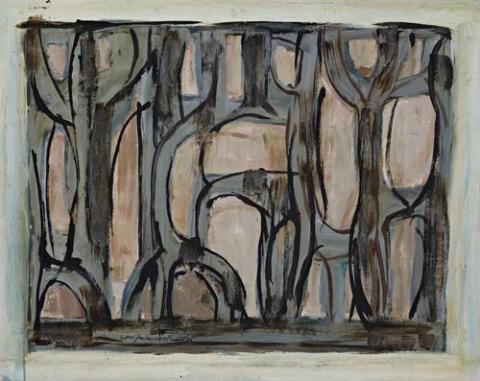PAINTING , 1960
Ian Fairweather
synthetic polymer paint on cardboard on composition board
70.5 x 88.5 cm
signed and dated lower left: Ian Fairweather 60 inscribed verso in chalk: AG520/ PURCHASED BY RUTH McNICHOLL [sic.]
Probably Macquarie Galleries, Sydney
Ruth McNichol, Argus Gallery, Melbourne
Dominion Art Galleries, Sydney
Private collection, New South Wales
Probably Ian Fairweather, Macquarie Galleries, Sydney, 6-18 July 1960 Dominion Art Galleries, Sydney, 10 November - 23 December 1964, cat.6 as 'Dance'
Dominion Art Galleries, Sydney, December 1965, cat.3 as 'Dance'
The present work appears in an advertisement for Dominion Art Galleries in Art and Australia, Ure Smith, Sydney, vol.4, no.1, June 1966, p.6
During 1959, at the age of sixty-nine, Ian Fairweather boldly turned to painting abstracts, describing his new work in gouache as 'sort of soliloquies- I suppose will have to come under the heading of abstracts.'1 In April of the following year he despatched a collection of sixteen paintings, mostly large, for exhibition at the Macquarie Galleries, Sydney in July. It is these works which Fairweather's biographer, Murray Bail, described as remaining 'among Australia's finest paintings- certainly the finest abstract painting- and fine enough to be shown without equation to the rest of the world.'2 Our painting is believed to be part of this group. Bail continued, writing how Fairweather 'consciously used abstraction to speak of experience beyond the experience of art itself. Painted in a winter of a long and difficult life the grey paintings arouse a subtle resonance, a contemplative serenity.'
The greys and simple earth colours in Abstract, 1960, are married to forms disarming in their harmonious quietude, a work of elegance and profound inner stillness. It is of the seeing and being that transcends thought. It is as Laurie Thomas wrote: 'He paints what he sees. But what he sees nobody else had seen until now.'3 While the critics' response to the exhibition reflected on Fairweather's new direction, the perceptive buyers bought well- the Art Gallery of South Australia acquired one of the 1959 gouaches, as did private collectors Pamela Bell and Mungo MacCallum. Larger synthetic polymer paintings of much the same size as ours were acquired by Mary Turner of the Macquarie Galleries, and later, the art connoisseur and future editor ofArt and Australia, Mervyn Horton, and the Art Gallery of Western Australia. Each was simply and directly titled- Painting. 'Their truthfulness [wrote Bail], their unforced search for a spiritual centre, clearly set them apart from other abstract painting in Australia.'4
1. Ian Fairweather letter to Treania Smith, Bribie Island, 11 November 1959, quoted in Murray Bail, Ian Fairweather, Bay Books Pty Ltd, Sydney, 1981, p.160
2. Ibid, p.161
3. Laurie Thomas, 'Ian Fairweather', Art and Australia, vol.1, no.1, May 1963, p35
4. Bail, op. cit., p.166
DAVID THOMAS
